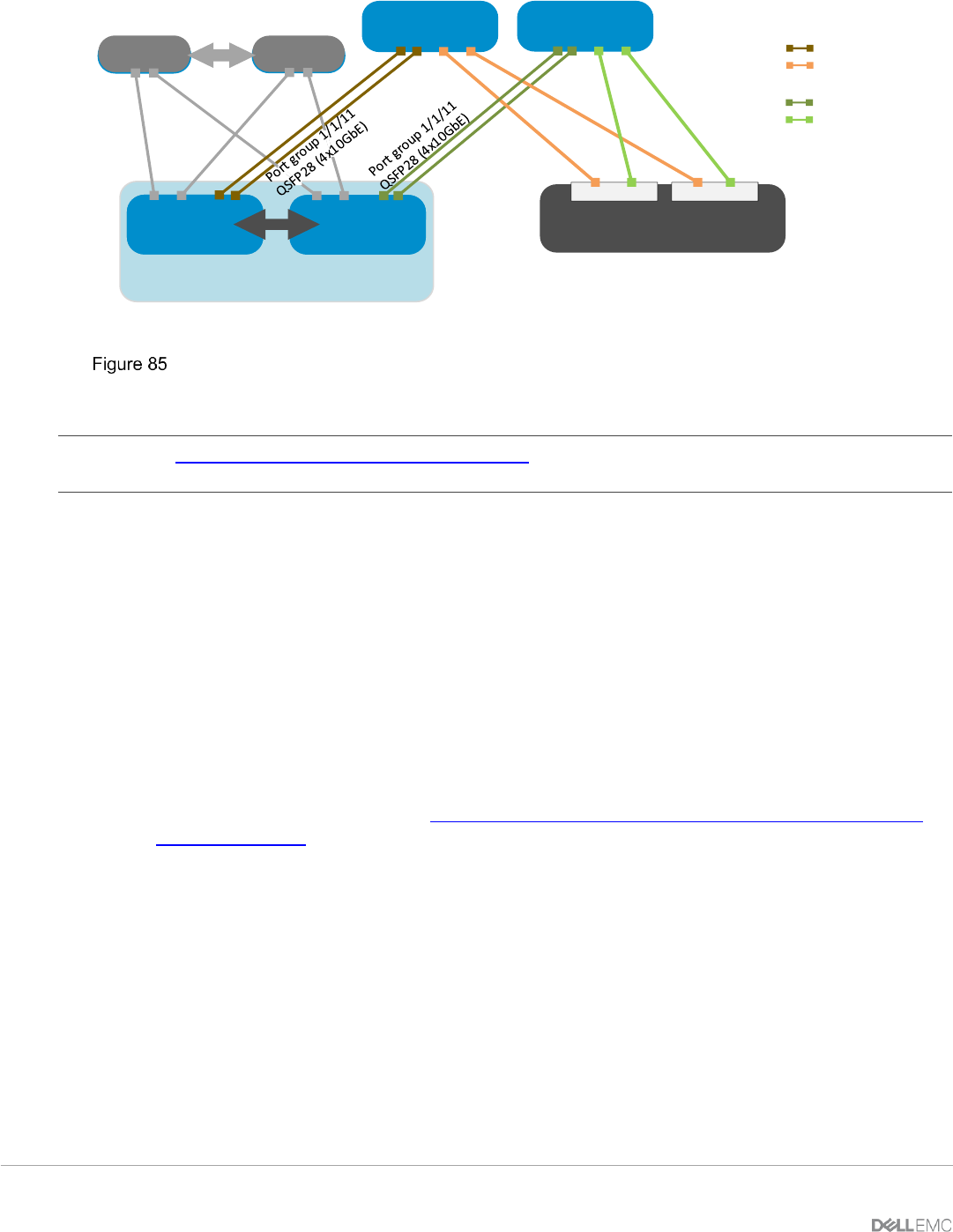Users Guide
Table Of Contents
- 1 Introduction
- 2 SmartFabric Services for PowerEdge MX: An overview
- 3 SmartFabric mode requirements, guidelines, and restrictions
- 3.1 Create multi-chassis management group
- 3.2 Upstream network requirements
- 3.3 VLAN scaling guidelines
- 3.4 Configuring port speed and breakout
- 3.5 Switch slot placement for SmartFabric mode
- 3.6 Switch-to-Switch cabling
- 3.7 NIC teaming guidelines
- 3.8 Maximum Transmission Unit (MTU) behavior
- 3.9 Other restrictions and guidelines
- 4 Creating a SmartFabric
- 4.1 Physically cable MX chassis and upstream switches
- 4.2 Define VLANs
- 4.3 Create the SmartFabric
- 4.4 Configure uplink port speed or breakout, if needed
- 4.5 Create Ethernet uplink
- 4.6 Configure Fibre Channel universal ports
- 4.7 Create Fibre Channel uplinks
- 4.8 Configuring the upstream switch and connect uplink cables
- 5 Deploying a server
- 6 SmartFabric operations
- 7 Switch operations
- 8 Validating the SmartFabric deployment
- 9 SmartFabric troubleshooting
- 9.1 Troubleshooting errors encountered for port group breakout
- 9.2 Troubleshooting Spanning Tree Protocol (STP)
- 9.3 Verify VLT/vPC configuration on upstream switches
- 9.4 Discovery of FEM and compute sleds
- 9.5 Troubleshooting uplink errors
- 9.6 Troubleshooting FC/FCoE
- 9.7 SmartFabric Services – Troubleshooting commands
- 10 Uplink configuration scenarios
- 10.1 Scenario 1 - SmartFabric deployment with Dell EMC PowerSwitch Z9100-ON upstream switches
- 10.2 Scenario 2 - SmartFabric connected to Cisco Nexus 3232C switches
- 10.3 Scenario 3: Connect MX9116n FSE to Fibre Channel storage - NPIV Proxy Gateway mode
- 10.4 Scenario 4: Connect MX9116n FSE to Fibre Channel storage - FC Direct Attach
- 10.5 Scenario 5: Connect MX5108n to Fibre Channel storage - FSB
- 10.6 Scenario 6: Configure Boot from SAN
- A Hardware used in this document
- B Dell EMC Unity information
- C Additional information
- D Validated components
- E Technical resources
- F Support and feedback

108 Dell EMC PowerEdge MX SmartFabric Configuration and Troubleshooting Guide
S4148U-ON
(F_port mode)
S4148U-ON
(F_port mode)
Unity 500F
MX5108n
FSB mode
(Leaf 2)
MX5108n
FSB mode
(Leaf 1)
VLT
MX7000 chassis
ToR switch 2
ToR switch 1
Unity 500F
Unity 500F
Controller A Controller B
VLT
FC SAN A
FC SAN B
FCoE SAN A
FCoE SAN B
FCoE (FSB) Network to Dell EMC Unity through F_port mode switch
Note: See the Dell EMC SmartFabric OS10 Documentation for configuring NPG mode globally on the S4148U-
ON switches.
10.5.1 SmartFabric configuration steps
This example assumes that an existing SmartFabric has been created and is fully operational. For instructions
on creating a SmartFabric, see Section 4.3.
1. To configure FCoE mode on an existing SmartFabric, the following steps are completed using the
OME-M console:Connect the MX switch to the S4148U. Note that the cables do NOT “criss-cross”
between the switches
2. Define FCoE VLANs to use in the fabric. For instructions, see Section 4.2.1 for defining VLANs.
3. Create Identity Pools if desired. See Section 5.3 for more information.
4. Create the FCoE uplinks. See Section 4.7 on creating Uplinks.
5. Create and deploy the appropriate server templates to the compute sleds. See Section 5.2 to 5.6 for
more information.
6. Configure the S4148U switch. See Dell EMC Networking Fibre Channel Deployment with S4148U-
ON in F_port Mode for more information
Once the server operating system loads the FCoE driver, the WWN displays on the fabric and on the FC
SAN. At that point, your system is now ready to connect to Fibre Channel storage. See Appendix B for setting
up storage logical unit numbers (LUNs).
To validate the configuration, use the same commands as Section 10.3.1.










